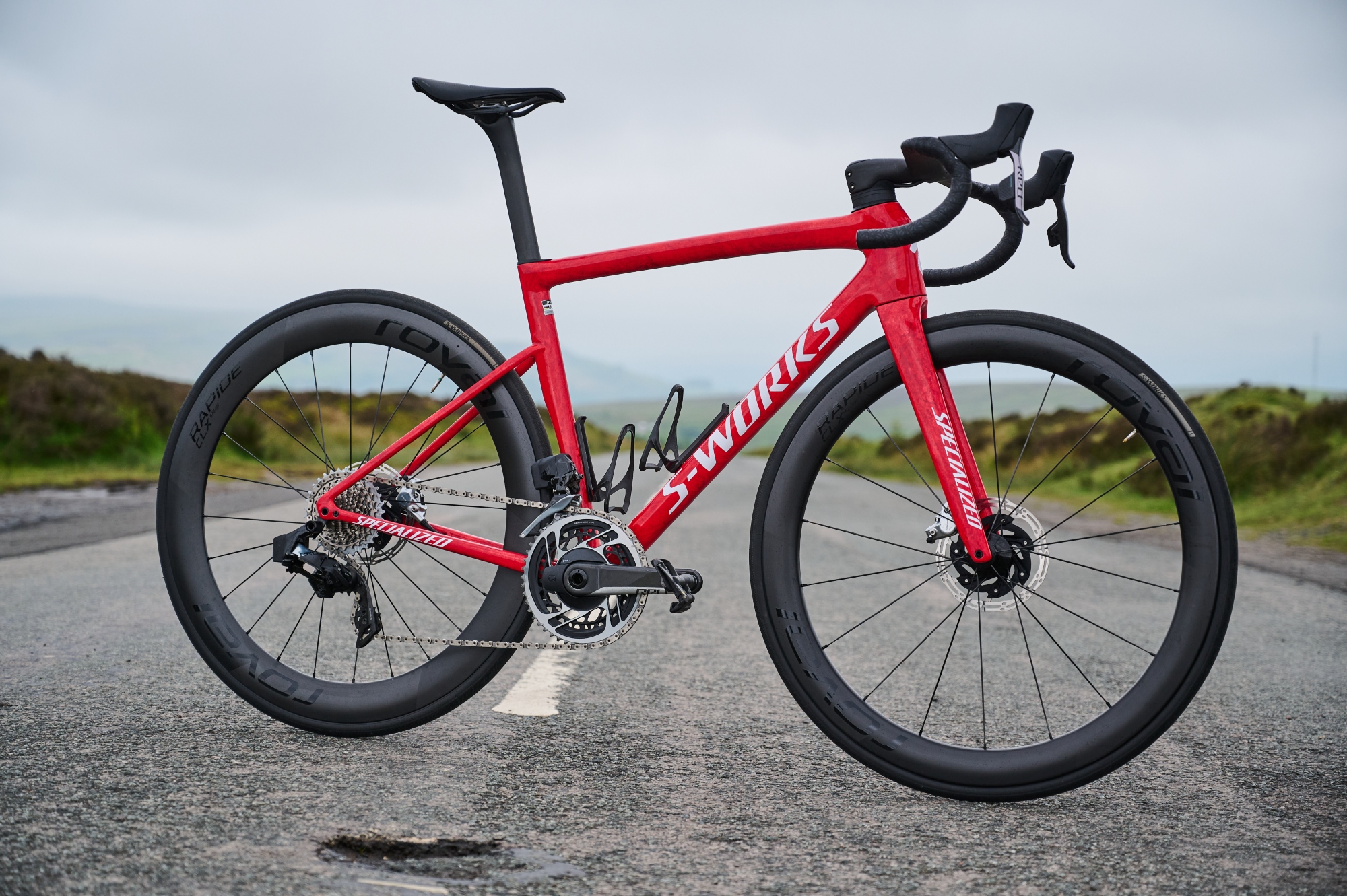
The Specialized S-works Tarmac SL8 was perhaps the most anticipated bike of last year, and since its launch has remained illustrious ever since its release at the UCI Cycling World Championships.
Since then, however, the SL8 has come up against some pretty stiff competition. Canyon released its new Aeroad, Van Rysel came out swinging with the RCR Pro, and Giant released the 10th generation TCR.
And with all the big names updating models which directly compete, it begs the quetsion, where does the Tarmac really sit in 2024? Has its once commanding performance lead waned, or does it rule the roost of the best road bikes on the market?
Let's take a look, twelve months on.
Specialized S-works Tarmac SL8: construction
First things first let's recap the Tarmac's design, starting with the bike's aesthetics. At a glance, the SL8 shares many similarities with its older relative (the SL7), so what exactly has changed?
The most drastic development comes in the bike’s frame shape. The chassis has taken on a much more rounded design, which Specialized claims are the product of its new ethos: ‘aero where it matters, not where it looks good’. Whilst I'd like to believe that this philosophy had been in place for the last decade, it's good to know it's the current approach.
The most polarising part of the design is the head tube, which Specialized has dubbed the ‘Speed Sniffer’ due to its less-than-beautiful (in my humble opinion) protrusion beyond the fork. It’s not dissimilar to the design of the Pinarello F, opting for more material in front of the steerer, rather than a longer trailing edge. As is often the case, now a year into its existence, the 'Speed Sniffer' doesn't seem to be quite as polarizing as it once was.
The changes, Specialized claim, lead to a 33% stiffness to weight increase thanks to lessons learned from the super light Aethos. In fact, The new SL8 started life as an Aethos in digital form. The Specialized engineers applied the carbon layup of the Aethos to the new SL8’s shape, where it then went through over 50 different computer-modelled iterations. Specialized says this allowed the engineers to increase stiffness and achieve a 685 gram frame weight (size 56), which is staggering if you believe the bike’s aerodynamic claims.

Geometry-wise, Specialized took an ‘if it ain’t broke, don’t fix it’ approach, and has changed precisely nothing, and I think this makes sense given the praise the SL7 received for its handling characteristics.
Finally, increased comfort. Specialized claim a 6% increase in vertical compliance, mostly thanks to a slimmer seatpost. It is particularly slender in design, which the brand says decreases its aerodynamic interference, and increases its flex to aid all-day comfort.
Specialized S-works Tarmac SL8: the ride
So then, how does Specilaized’s plethora of marketing claims stack up in the real world? The short answer is, incredibly well. And while it’s undoubtedly an amazing bike, I don’t think it’s quite for the reasons that Specialized claims.
My first ride on the new bike - last year - was a memorable one, made up of twisty Scottish lanes just outside of Glasgow. What was immediately noticeable was that no more than 25 minutes into the ride, I was totally confident throwing the bike down damp and winding descents. The head tube stiffness made for very assured handling - something that was tangibly better than other bikes I have tested. The new Roval Rapide cockpit too was certainly pretty rigid, which makes a huge difference to the bike’s handling - though I wish they would offer some slightly narrower options, with 38cm being the smallest (and a 115cm stem the longest).
Specialized has also chosen to forego total internal cable routing for a channel underneath the stem which means you can still change handlebar height without brake bleeding.

Bottom bracket stiffness too was impressive given the bike’s weight, though I wouldn’t say perfect. Interestingly, this is where Specialized said the biggest gains were to be found, but when sprinting all out, leaning the bike over to apply as much force as possible to the bottom bracket, I did feel some deflection. This can be caused by tyre deformation, but when you do the maths, experiencing some bottom bracket deflection at a torque of around 120Nm is realistic.
My pleasure when riding this bike hasn't decreased as time has gone on. In fact, I have covered more miles over the last few months than I usually would, and I genuinely put this down to my excitement at having the opportunity to ride Tarmac SL8. The bike is markedly more compliant at the rear end, and together with 26mm tyres I think it's a combination that most riders who are used to stiff race bikes will be pleasantly surprised by. That said, if you’d like more cushioning the SL8 can fit up to 35mm of rubber, which means you could comfortably ride your £12,000 bike through the winter, if you really wanted to.
I have been lucky enough to spend more than 1000km on the new Tarmac over the last twelve months, after initially testing it for review last year, and subsequently pitting it against a host of competitors in our bumper Race Bike of the Year 2024 test.
Over this time frame, it has seen pretty much all of my local riding routes around Oxfordshire, tackling the steep climbs and descents of the Cotswolds, the dire bumps and potholes of the Chiltern hills, as well as excursions further afield in the Brecon Beacons.
Throughout testing, I have been thoroughly impressed at just how well the Specialized Tarmac SL8 tackles such a wide range of terrain. 'One bike to rule them all' might be quite a cheesy slogan, but I have to say Specialized has made this as close to reality as any bike brand has done so far.
The Tarmac’s trump card though, is how well it holds its speed. The combination of stiffness and aerodynamics excels on rolling terrain, and will undoubtedly transfer to real-world racing, where you save energy with every single small acceleration. No, we haven’t had the bike in the wind tunnel, and yes the claims of a 16-second saving over the outgoing bike are, in my opinion, pretty weak when you consider that Specialized admitted that “more than 50%” of the aerodynamic advancements come from the handlebar alone, but this brings me to how I think the Specialized Tarmac SL8 is slightly misunderstood.
Specialized is brilliant at marketing - that’s no secret, but this far into the product development cycle, even the best marketers are left in a tricky position. The brand’s emphasis on measurable gains, like weight and aerodynamics (which are pretty small) has led to a lot of scepticism, and that takes away from how impressive the new bike is as an engineering system.
As someone who has raced at a high level on the continent, I can happily say that the bike performs so well across all categories that there is no real standout feature - it just does exactly what I want a race bike to do, which is to be as fast as possible over a variety of terrain. When you boil it down to that, I don’t think any race bike currently does that better than the Tarmac SL8.
Specialized S-works Tarmac SL8: 2024 ranking
Simply put, the Specialized S-works Tarmac SL8 is the best race bike I have ever ridden. In terms of how well it fits the brief, of a singular bike that must be quick over all terrains, nothing has managed to surpass the Tarmac - but the gap is narrowing.
In our Race Bike of the Year testing, for example, when riding the Tarmac back to back with the latest generation Giant TCR, I experienced for the first time a bike that managed to dance with a little more flair on steep climbs. The TCR's lower weight and brilliant stiffness was tough competition, however in other categories, the Tarmac still pulls away.

The same is true of the Look 795 Blade RS I have ridden more recently - yes it may be stiffer, but point the two bikes up hill, and (all things being equal), the Tarmac will surely reach the top first.
To conclude, then, the Specialized S-works Tarmac SL8 does remain my benchmark at the end of 2024. What has changed though, is some bikes, like the TCR may just be able to edge out the Tarmac in specific areas.







